6. Case studies
Collections of oral history recordings
Case Study: Imperial War Museum, London, England.
(a) Collection
The Museum's collection comprises over 6,000 hours, 90% of which is speech, consisting mainly of oral history interviews conducted by Museum staff and of broadcast material. The remainder consists of music, sound effects, etc.
(b) Cataloguing Staff
Cataloguing is the primary responsibility of two graduate staff, who also have other duties; they receive advice from the Museum's Department of Information Retrieval. Occasional use is made of 'casual' staff (i.e. staff on short-term appointments), and increasingly of contributions to the documentation of their own interview material by oral history field workers (see gi below).
(c) Catalogue
Within the Museum, catalogue information is accessible on computer-output microfiches which replace a card catalogue. Catalogues to completed oral history projects (see gii) and to other coherent sub-collections are published as part of the Department of Sound Records' public service.
(d) Catalogue System
The sound records collection is included in the scope of the Museum's overall cataloguing policy. From 1977 to 1982, the collection was catalogued using a modified version of APPARAT, a computerised system developed by the Museum initially for its film collection. From 1983, all Museum cataloguing, including sound records, will use the computer package GOS developed by the Museum Documentation Association. Catalogue information is supplemented in some cases by transcripts and personal files.
(e) Indexes
GOS will be capable of maintaining a keyword subject index in addition to a combined index of people interviewed (including name changes etc.), and of generating other indexes at need. Short listings for completed oral history projects also provide a useful tool for visiting researchers.
(f) Example
See figure 1 for a sample entry from the APPARAT microfiche; entries were arranged in accession number order.
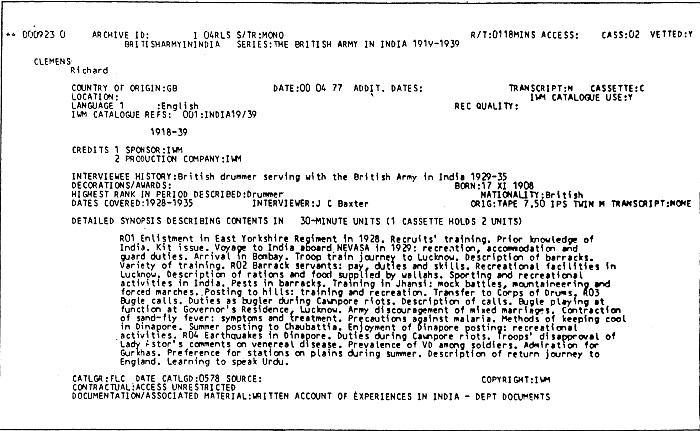 Figure1
Figure1
(g) Comments
i. The number of cataloguers has not proved large enough to keep pace with the oral history acquisitions generated by the three interviewers on the Museum staff, and the freelance interviewers who are also employed. (There is of course also the non-oral history material). The two expedients mentioned in (b) above represent attempts to prevent the growth of a backlog of uncatalogued material.
ii. The Museum's oral history collection policy is geared to 'projects' of interviews on specific topics, and thus lends itself to the publication of catalogues to sub-collections. Compare with the relatively open-ended research orientation of, for example, the Welsh Folk Museum which forms the subject for the next case study.
Collections of folklife and language recordings
Case Study: Arngueddfa Werin Cyrnru (Welsh Folk Museum), Cardiff, Wales.
(a) Collection
The collection comprises over 3,750 hours, 85% of which is speech, consisting mainly of folklife recordings made by Museum staff.
(b) Cataloguing Staff
The ten or so members of the Museum staff who make field recordings (and who generate in all about 200 tapes per year) are responsible for preparing summaries of their own recordings. A central section of three people (one graduate, one assistant and one typist), who also have other responsibilities, manages all registration and central indexing work and prepares summaries for tapes that are not properly documented (see gi).
(c) Catalogue
A card catalogue is maintained within the Museum. There are no published catalogues.
(d) Catalogue System
The catalogue is based on two types of card: cards for speakers, arranged alphabetically and containing biographic information, and cards for interviews, arranged numerically and containing tape summaries. The card catalogue is supplemented by transcripts etc. (see gii).
(e) Indexes
The dual nature of the central catalogue makes it partially self-indexing. In addition, optical feature cards are used in a 'post-coordinate' indexing system controlled by a bi-lingual thesaurus of keywords developed by the Museum. Specialist indexes appropriate to their own research are generated by individual field workers.
(f) Examples
i. The front of a speaker card is illustrated in Figure 2. (Headings are in Welsh; English translations have been supplied.) The reverse of the card lists the tapes that contain interviews with the speaker, and provides spaces to describe or evaluate the speaker's suitability for interview, usage of the Welsh language, etc. Eleven headings are provided, including 'Correctness of language'; 'Sociability'; 'Memory'; ' Pronunciation'.
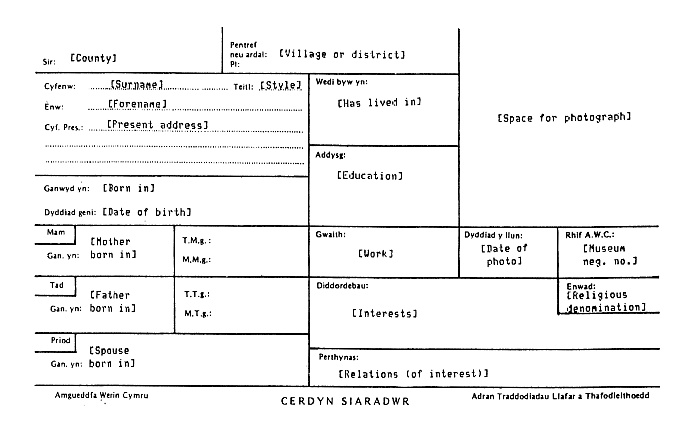
Figure 2
ii Figure 3 shows the front of an interview card. The reverse of the card continues the list of contents and provides space for entries on 'Place of recording'; 'Personality and atmosphere'; 'Additional voices on tape'; 'Purpose of recording'; 'Value of recording'; 'Sound quality'.
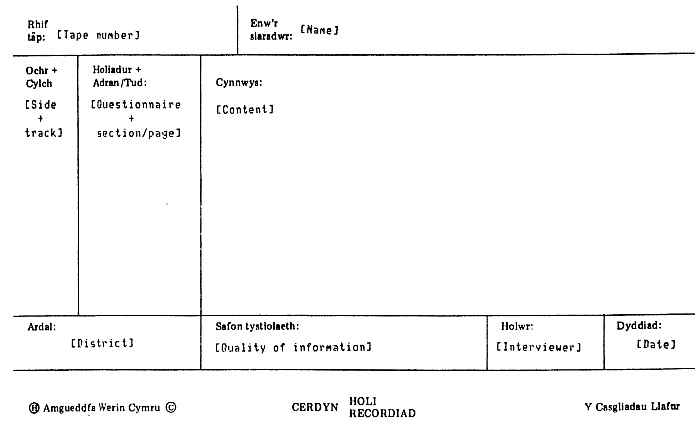 Figure 3
Figure 3
(g) Comments
i. Recordings at the Amgueddfa Werin Cyrnru represent 'research in progress' for Museum staff -as distinct from, for example, the project-based work of the Imperial War Museum. The documentation supplied by field workers is therefore analogous to research notes. The central cataloguing staff is considered to be of about the right size, although a team of this size without other responsibilities would be better still.
ii. The dual card catalogue is a clever solution to a significant problem in cataloguing field recordings (especially of speech) -their tendency to generate catalogue entries of great length, which can make the design of a single catalogue card difficult. On the other hand, this system, which also includes an accession register in which some biographic information is recorded, must involve some duplication of effort. Note also the quantity of subjective evaluation anticipated by the cards. Although quite appropriate to research notes, this sort of entry would not normally be expected in a catalogue to which there was to be much public access and in fact access to the catalogue is restricted to approved users only.
Collections of wildlife recordings
Case Study: British Library of Wildlife Sounds, British Institute of Recorded Sound, London, England.
(a) Collection
A self-contained collection within the total holding of BIRS (67,000 hours), BLOWS has some 1,000 hours or 25,000 recordings covering well over 5,000 species. The collection consists of commercial recordings, copies of BBC material and privately-made recordings.
(b) Cataloguing Staff
The collection has no cataloguing staff as such, the total staff of BLOWS is one person. Documentation of non-commercial recordings relies on notes supplied by the individual responsible for the recording; BBC material relies on BBC catalogues. Overall documentation policy at BIRS is decided at Institute level (see g).
(c) Catalogue
The collection is covered by catalogue’s maintained at the Institute on cards and data sheets and by BBC Natural History Sound Archives catalogues. BLOWS publishes discographies for commercial recordings on particular subjects (e.g. African bird sound).
(d) Catalogue System
BLOWS will come within the scope of any long-term decisions taken about the cataloguing of the collections of BIRS as a whole. For the present, BLOWS documentation remains based on manual catalogues: a card catalogue for commercial recordings, and the 'Field and editing notes' data sheets developed for completion by field recordists for private recordings.
(e) Indexes
In so large a collection with so small a staff, various expedients are used to provide finding aids. Data sheets are filed by family and scientific name of species; they are thus effectively self-indexing. A separate card index is maintained for species covered by commercial recordings. BLOWS also annotates (annually) a copy of an authoritative published checklist of bird species to create a guide to its collection. Noted as desirable for inclusion when resources and capability permit are indexes by geographical location, habitat, type of sound, recordist etc.
(f) Examples
i. Field recording data sheet is illustrated as Figure 4.
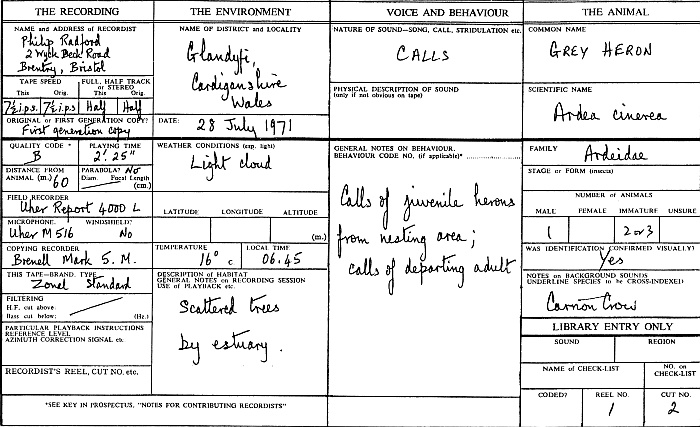 Figure 4
Figure 4
ii. The draft of a format for a computer catalogue derived from Example i is shown [below].
Ardea cinerea GREY HERON
Calls. 1 adult and 2 or 3 juveniles. Identified visually. Calls of juveniles from nesting area and calls of departing adult.
Background Carrion Crow.
Glandyfi, Cardiganshire, Wales. Scattered trees by estuary.
29 July 1971. 05.45. 50 Metres distant. Microphone on branch with 100 metre lead.
2'.25". B quality. Uher 4000 Report L. Uher M.516. First generation copy.
Dr Philip Radford. Tape. 19 cm/sec. ½ track Mono.
Reel 1, Cut 2. No. 1710.
(g) Comments
BLOWS demonstrates the kinds of ingenious expedient to which a collection committed to the provision of an adequate public service may have to turn in the absence of adequate staffing. Preliminary studies for computerisation in the mid-1970s suggested that the preparation of data on the extant collection for entry into a new system would require two years' work by a specialist cataloguer. It has also been calculated that the current accession rate - approximately 1,000 private, 500 BBC and 100 commercial recordings per year, - would justify, funds permitting, one full-time cataloguer.
Collection of ethnomusicology and language recordings
Case Study: Australian Institute of Aboriginal Studies, Canberra, Australia.
(a) Collection
The Institute's collection comprises over 8,000 hours, 70% of which is speech, 30% music. Material collected by anyone awarded a research grant by the Institute (including Institute staff) is deposited as a condition of such a grant; deposits from other sources are also welcomed. A range of restrictions on the use of and access to recordings is maintained by the Institute and recorded on each contract of deposit.
(b) Cataloguing Staff
Cataloguing is the responsibility of two graduate staff, both with field work experience, and one typist. All have other duties (see gi).
(c) Catalogue
Within the Institute, a card catalogue is maintained, supplemented by access from a computer terminal inside the Institute to an on-line data base. Lists of new accessions and catalogues to coherent sub-collections are published -some in microfiche format.
(d) Catalogue System
A card catalogue is used, with entries being complemented by audition sheets (which provide a detailed, timed analysis of the contents of the tape as heard), transcripts, records on restrictions etc. (see gii). Part of the collection has been catalogued using IQL (Interactive Query Language) as a pilot project.
(e) Indexes
The manual card catalogue is indexed by location of recording, song titles and series, languages and subject codes; a file of informants' names is maintained separately, and is accessible to approved users only. Under IQL, any information field contained within a catalogue entry may be the basis of an enquiry.
(f) Examples
i. The catalogue card, reproduced below is filed alphabetically under collector's name. Marginal notations give tape number and restriction indicators. Library codes indicate origins (e.g. Qld/G meaning Queensland, Gulf area), content (20A/3 meaning body painting; 19W/2 meaning discussion of song and song words), and style of performance (19VU meaning unaccompanied singing by one man, 19B an elicited performance etc.). Language names are listed at the end of the codings.
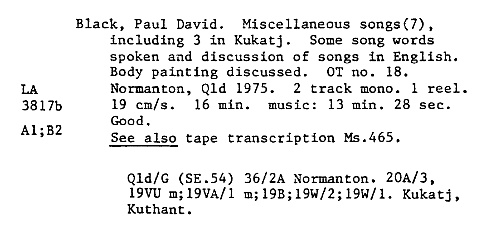
ii. The fields available for a computerised catalogue record under IQL pilot project are shown in figure 7.
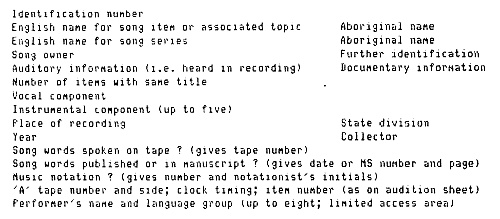
Figure 5 illustrates what a full catalogue entry printed out by the computer looks like.
 Figure 5
Figure 5
(g) Comments
i. The number of cataloguers has not proved large enough to keep pace with accessions currently estimated at circa 1,000 tapes per year. It is thought that additional clerical and typing staff could help; schemes for training Aboriginal cataloguers have also been initiated.
ii. The use of codes to standardise variant spellings of language types and to delineate 'tribal areas', the importance given to the question of restrictions on access to recordings, the provision of a catalogue field label recognising the Aboriginal concept that songs are owned not composed, and other details visible in the examples are all conspicuous reminders of the difficulty of documenting material from different cultural traditions. The IQL format developed at AIAS is a pragmatic response to these difficulties.
Collection of commercial recordings in a broadcasting archive
Case Study: Nederlandse Omroep Stichting, Hilversum, The Netherlands
(a) Collection
In a large and rapidly growing collection, a total size is difficult to estimate. In January 1981, the collection included over 200,000 discs (about 85,500 hours, 95% music) and about 180,000 tapes (about 76,000 hours, 80% music). The main archival concern is with recordings made by NOS itself. In addition to music,
the archive has oral history, folklore and sound effects collections.
(b) Cataloguing Staff
In the commercial record department, seven of a staff of twenty employees are occupied with cataloguing tasks. The tape archive has six and the oral history department has five 'reviewers' (see gi).
(c) Catalogue
An on-premises computer-output microfiche system is in use, supplementing and increasingly replacing a card catalogue. No publications have been printed as the archive has no public role.
(d) Catalogue System
Since 1975 SYFON (SYsteem FONotheek), a computerised system, has been replacing the previous card-based catalogue. Information is stored in a format devised by NOS staff. Of particular interest is the development of an alpha-numerical classification system HOUDINI providing information on genre, period, national or linguistic origin, function etc. (see gii).
(e) Indexes
Indexes are maintained for title, composer, performer, keyword, classification and (for NOS recordings) radio licensee and date. Most indexes give full information for each recording cited.
(f) Examples
i. Figure 6 shows two cards from the superseded manual catalogue, both refer to the same principal work ('Orkestsuite No.2') but provide details of different recordings of different extracts ('Badinerie' and Menuet') from that work. Note also that two recordings are listed on each card to conserve space.
ii. Figure 7 shows representative SYFON entries which are arranged by HOUDINI classification strings (see gii).
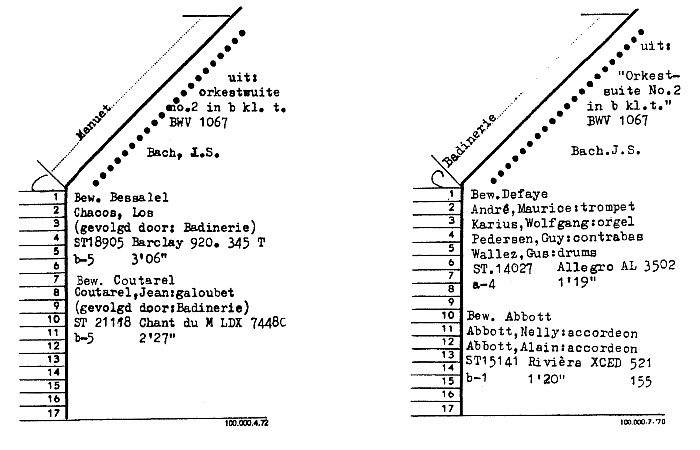
Figure 6
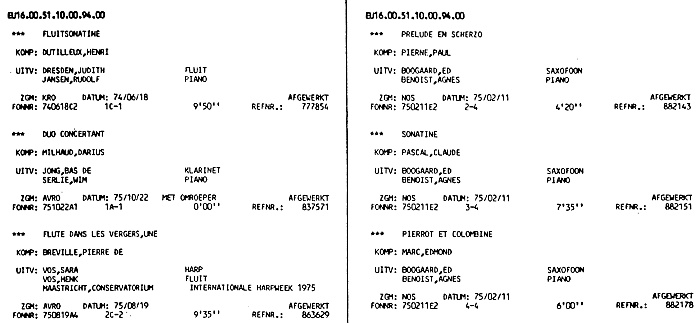
Figure 7
(g) Comments
i. The documentation staff complement in the tape archive is considered large and will be reduced when work is completed on the backlog of poorly documented material. The number of 'reviewers' of oral history, on the other hand, is considered low and will be increased if possible.
ii. HOUDINI would function best in circumstances where on-line interrogation of the catalogue was possible, but produces a useful classification/index for users even in off-line usage. HOUDINI classification 'strings' are made up of seven elements as follows:
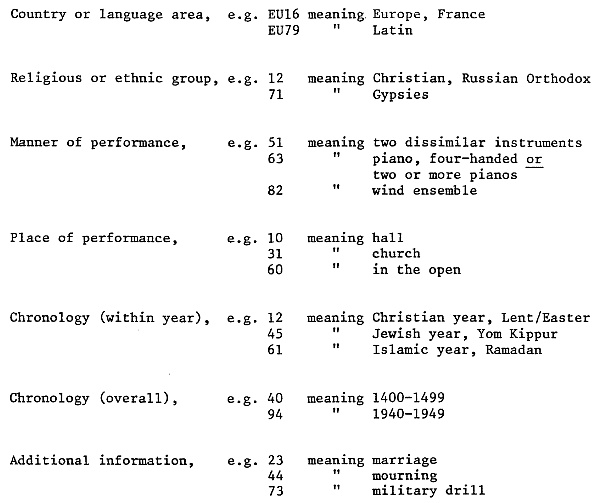
The appearance of these strings may be seen at the top of figure 7; the strings may be decoded from the information just given. 00 is entered to indicate a 'null' entry for a given topic.